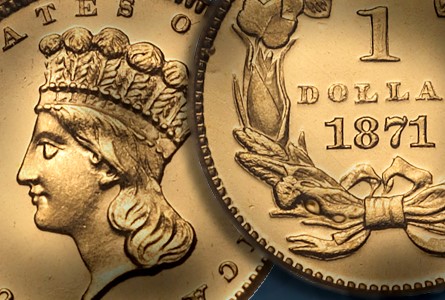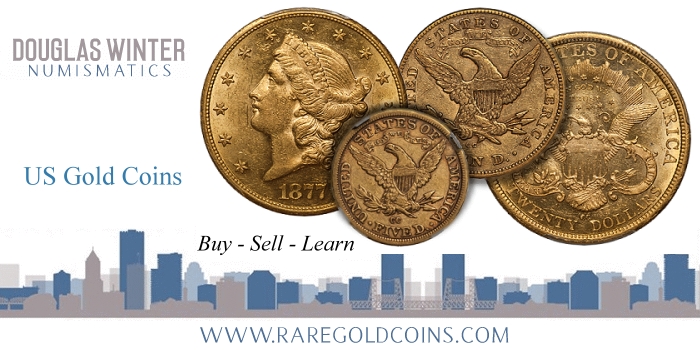Proof Gold Coins By Doug Winter – RareGoldCoins.com ……
CoinWeek Content Partner ……
Having recently handled a considerable number of impressive Proof gold coins, I’ve been thinking about when a specific coin is worth a premium because of is status as a Deep Cameo (PCGS) or Ultra Cameo (NGC). After a brief explanation of these terms, I’d like to use a few examples of the coins I’ve sold to illustrate scenarios in which I feel a premium is merited.
 Proof gold coins are struck specially for collectors in very limited numbers. They are made with care using specially prepared planchets and typically struck with multiple blows of the dies. One of the features of most pre-1900 American gold coins in Proof is that they show cameo-like contrast between the devices (which are frosted) and the fields (which are watery and reflective). Collectors appreciate this appearance; as well they should, as a gold coin with deep, strong cameo contrast can have wonderful eye appeal.
Proof gold coins are struck specially for collectors in very limited numbers. They are made with care using specially prepared planchets and typically struck with multiple blows of the dies. One of the features of most pre-1900 American gold coins in Proof is that they show cameo-like contrast between the devices (which are frosted) and the fields (which are watery and reflective). Collectors appreciate this appearance; as well they should, as a gold coin with deep, strong cameo contrast can have wonderful eye appeal.
The question most collectors ask about cameo proof gold coins is when are such pieces worth a price premium.
Given the fact that most pre-1900 proof gold coins have very low mintage figures, we can assume that nearly every piece is going to show some degree of cameo. But there are a few coins for each year that have extreme cameo contrast. We can assume that these are either the very first pieces produced or they were coins that were made with extra care for their visual appeal.
Let’s look at a proof gold coin with an original mintage figure of 30 coins as an example. The typical survival rate for a proof gold coin struck between 1860 and 1880 is around 50% (for large denominations such as eagles and double eagles this figure is probably more like 25-33%). Given this figure, let’s say that 15 or so are known.
Of these 15, there are probably at least a few that are either impaired or they have been cleaned and/or processed to the point that they do not have an original appearance. So let’s say the number of pertinent coins is around 10. There might be seven or eight that have been graded by PCGS and/or NGC and given the designation “cameo.” Then let’s say that the other two or three coins have been designated as “ultra cameo” or “deep cameo.” How much more are these coins worth?
In my opinion, if these coins have great eye appeal and are not overgraded, they are probably worth a 10-20% premium over a regular cameo example. This is making the assumption that they are significantly rarer than their regular cameo counterparts. In the case or large denominations, where eye appeal is so critical, this premium might even be a bit higher.
I’d like to use two specific coins to illustrate my theory about ultra cameo/deep cameo premiums. These are a pair of gold dollars that I recently sold.
The first coin is an 1862 gold dollar graded PR66 Deep Cameo by PCGS and awarded a sticker by CAC.
This Civil War issue has an original mintage figure of 35 coins, of which slightly fewer than half survive. In my experience, the United States Mint did an excellent job of producing proof gold coins in 1862 and the overall quality of most of the gold dollars I’ve seen has been above average. In other words, Proofs of this year are supposed to come with good contrast and there should be no premium whatsoever for a coin that is a regular cameo.
But if you take even a casual look at this specific coin, you’ll see that it has incredible eye appeal. The appearance is “black and white” with the type of contrast that can literally be seen across the room. I felt that this was one of the best looking Proof gold dollars that I had ever viewed and this was a reason that I purchased the coin at the 2012 FUN show.
As I was figuring a value for this coin, I had to decide on what sort of a premium its beauty would compel me to pay. I certainly wouldn’t have paid a 50% premium (although in certain silver series, a premium of this sort isn’t uncommon) but I felt a 10-20% premium was certainly in keeping with its stunning appearance.
This was an instance where I wasn’t so much paying a premium for an ultra cameo coin’s rarity (there are a few other 1862 gold dollars known with a deep cameo/ultra cameo appearance) as I was for its beauty. What was even more appealing to me was the fact that this coin has a “natural” deep cameo appearance.
You’ve almost never seen proof gold coins anymore with the old-time, deep, hazy look that you used to see when collections like Norweb, Pittman, Eliasberg or Childs were sold. In fact, I would venture to say that most collectors and dealers who have entered the hobby after 1990 have seen virtually no truly original Proof gold coins. A welcome exception to this was the amazing Henry Miller collection of Proof gold that Heritage sold at their FUN auction in January 2011. While not every coin in this group was original, some were just amazing and it was refreshing to see Proof gold coins that looked like this after so many years of character-free pieces being offered…
What’s even harder to find these days are “old-time gem” proof gold coins that aren’t so hazy or richly colored that they don’t show deep cameo contrast. That’s why a coin like this 1862 dollar is special, in my opinion, and it merits a strong premium. It was original yet it was commercially viable for those collectors who don’t “get” originality.
The next coin I’d like to discuss is a PCGS PR65 Deep Cameo 1871 gold dollar also awarded approval by CAC. While this coin has a mintage which is close to the 1862 (a total of 30 versus 35 for the 1862) it is rarer due to the fact that it appears that a portion of the mintage was melted after the coins went unsold in 1871. It is possible that as few as eight to 10 are known and this is actually one of the single rarest Type Three dollars in proof.
One interesting fact about this date is that it is not a year that tends to come as well made as the 1862. In 1871, the amount of contrast wasn’t as great and many survivors in all gold denominations show lint marks or slight planchet irregularities. It is also a date that, as a Proof, tends to be a little rarer than the 1862 in higher grades. I believe that this 1871 is the second finest known, trailing just a single PR68 at NGC.
This coin has nice cameo contrast although not as much so as on the 1862. In the case of this coin, I think its premium is predicated more on rarity than on extreme eye appeal. It is the only PCGS example in PR65 or better to have been designated as a Deep Cameo and this fact, I believe, gives it at least a 10-15% premium over a regular cameo example in the same grade.
In summary, I feel that the two reasons to ascribe a strong premium to any proof gold coin due to its status as a deep cameo/ultra cameo are either extreme eye appeal (or beauty) and extreme rarity (status as the only example of an issue with this designation or else the single highest graded with this designation). Obviously, the best scenario is a proof gold coin that is both extremely rare and extremely beautiful. In this case, the premium could be very high; maybe as much as 25-50%.
* * *
About Doug Winter
 Doug has spent much of his life in the field of numismatics; beginning collecting coins at the age of seven, and by the time he was 10 years old, buying and selling coins at conventions in the New York City area.
Doug has spent much of his life in the field of numismatics; beginning collecting coins at the age of seven, and by the time he was 10 years old, buying and selling coins at conventions in the New York City area.
In 1989, he founded Douglas Winter Numismatics, and his firm specializes in buying and selling choice and rare US Gold coins, especially US gold coins and all branch mint material.
Recognized as one of the leading specialized numismatic firms, Doug is an award-winning author of over a dozen numismatic books and the recognized expert on US Gold. His knowledge and an exceptional eye for properly graded and original coins has made him one of the most respected figures in the numismatic community and a sought after dealer by collectors and investors looking for professional personalized service, a select inventory of impeccable quality and fair and honest pricing. Doug is also a major buyer of all US coins and is always looking to purchase collections both large and small. He can be reached at (214) 675-9897.
Doug has been a contributor to the Guidebook of United States Coins (also known as the “Redbook”) since 1983, Walter Breen’s Encyclopedia of United States and Colonial Coins, Q. David Bowers’ Encyclopedia of United States Silver Dollars and Andrew Pollock’s United States Pattern and Related Issues
In addition, he has authored 13 books on US Gold coins including:
- Gold Coins of the New Orleans Mint: 1839-1909
- Gold Coins of the Carson City Mint: 1870 – 1893
- Gold Coins of the Charlotte Mint: 1838-1861
- Gold Coins of the Dahlonega Mint 1838-1861
- The United States $3 Gold Pieces 1854-1889
- Carson City Gold Coinage 1870-1893: A Rarity and Condition Census Update
- An Insider’s Guide to Collecting Type One Double Eagles
- The Connoisseur’s Guide to United States Gold Coins
- A Collector’s Guide To Indian Head Quarter Eagles
- The Acadiana Collection of New Orleans Coinage
- Type Three Double Eagles, 1877-1907: A Numismatic History and Analysis
- Gold Coins of the Dahlonega Mint, 1838-1861: A Numismatic History and Analysis
- Type Two Double Eagles, 1866-1876: A Numismatic History and Analysis
Finally, Doug is a member of virtually every major numismatic organization, professional trade group and major coin association in the US.





